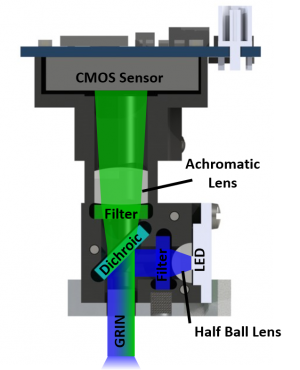Here is the basic optics for our system. Please use this forum to discuss any questions related to Optics!
 Cross section of scope. Excitation path is in blue. Emission path is in green. The optical path of the miniature microscope is very similar to a tabletop wide-field fluorescence microscope. The main difference is the size of the optical elements and the use of a GRIN lens as an objective. A more detailed discussion on GRIN lenses can be found here.
The optics in the miniscope use off the shelf lenses and diced commercial filters. Excitation light generated by an LED passes through a half-ball lens to help collimate the light
which is then bandpassed through an excitation filter and reflected using a dichroic mirror.
Emission light exits the objective GRIN lens in roughly a parallel orientation, passes through the dichroic mirror and then bandpassed through an emission filter. The light is then focused onto the CMOS imaging sensor using an achromatic lens.
Posted by Tristanshuman (administrator) on 2 December 2015 at 19:57.
Edited by Tristanshuman (administrator) on 14 January 2016 at 16:37. |
|